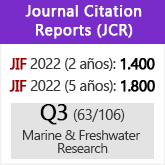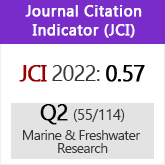Predicción de la edad de juveniles de sardina (Sardina pilchardus) a partir de las características de los otolitos y las características morfométricas
DOI:
https://doi.org/10.3989/scimar.04143.16APalabras clave:
edad diaria, otolito, sardina, peso de otolito, diámetro de otolito, norte de PortugalResumen
Un modelo de edad-predicción basado en las características individuales (longitud total; peso) y en las características de los otolitos (diámetro; peso) fue investigado para los juveniles de sardina, Sardina pilchardus (Walbaum, 1792). Juveniles fueron recolectados en el Norte de Portugal entre Mayo de 2004 y Enero de 2005. Los anillos de crecimiento diarios fueron contados a partir de los otolitos correspondientes a 114 juveniles entre los 7-16 cm de longitud total. La muestra fue dividida en una muestra de entrenamiento para desarrollar el modelo de edad-predicción y una muestra de prueba usada para evaluar la habilidad predictiva del modelo. El mejor modelo para predecir el logaritmo de la edad fue un modelo de regresión lineal con el diámetro de otolito. La predicción de las edades diarias fue más precisa para los individuos más jóvenes ( < 200 días). En conjunto, las edades estimadas a partir del modelo no fueron significativamente diferentes de las determinadas con los contajes de microincrementos. Las edades diarias estimadas reprodujeron de forma correcta la distribución de las edades observadas y proporcionaron estimativas comparables de crecimiento (0.041 cm dia–1). El retrocálculo del período de la fecha de nacimiento osciló entre el 29 de Septiembre de 2003 y el 22 de Julio de 2004, con un pico en Enero de 2004, fecha consistente con el período reproductor. El modelo presentado en este estudio puede ser usado cómo un método para incrementar el volumen de datos referentes a edades diarias. Debido a las variaciones espaciales y temporales en el crecimiento y supervivencia de los individuos, las relaciones morfométricas referentes a edad-otolito/pez no deben ser extrapoladas fuera de los períodos de muestreo, áreas de muestreo y talla peces/edad.
Descargas
Citas
Alemany F., Álvarez F. 1994. Formation of initial daily increments in sagittal otoliths of reared and wild Sardina pilchardus yolksac larvae. Mar. Biol. 121: 35-39. http://dx.doi.org/10.1007/BF00349471
Alemany F., Álvarez I., García A., et al. 2006. Post larvae and juvenile daily growth patterns of the Alboran Sea sardine (Sar- dina pilchardus, Walbaum): influence of wind. Sci. Mar. 70S2: 93-104.
Álvarez F., Alemany F. 1997. Birthdate analysis and its applica- tion to the study of recruitment of the Atlanto-Iberian sardine, Sardina pilchardus. Fish. Bull. 95: 187-194.
Baumann H., Voss R., Hinrichsen H.-H., et al. 2008. Investigating the selective survival of summer- over spring-born sprat, Sprat- tus sprattus, in the Baltic Sea. Fish. Res. 91: 1-14. http://dx.doi.org/10.1016/j.fishres.2007.11.004
Bernal M., Stratoudakis Y., Coombs S., et al. 2007. Sardine spawning off the European Atlantic coast: Characterization of and spatio-temporal variability in spawning habitat. Prog. Oceanogr. 74: 210-227. http://dx.doi.org/10.1016/j.pocean.2007.04.018
Campana S.E., Neilson J.D. 1985. Microstructure of fish otoliths. Can. J. Fish Aquat. Sci. 42: 1014-1032. http://dx.doi.org/10.1139/f85-127
Coombs S.H., Smyth T.J., Conway D.V.P., et al. 2006. Spawning season and temperature relationships for sardine (Sardina pilchardus) in the eastern North Atlantic. J. Mar. Biol. Assoc. U. K. 86: 1245-1252. http://dx.doi.org/10.1017/S0025315406014251
Fey D.P., Linkowski T.B. 2006. Predicting juvenile Baltic cod (Gadus morhua) age from body and otolith size measurements. ICES J. Mar. Sci. 63:1045-1052. http://dx.doi.org/10.1016/j.icesjms.2006.03.019
Fletcher W.J. 1991. A test of the relationship between otolith weight and age for the Pilchard Sardinops neopilchardus. Can. J. Fish. Aquat. Sci. 48: 35-38. http://dx.doi.org/10.1139/f91-005
Fletcher W.J. 1995. Application of the otolith weight-age relationship for the Pilchard, Sardinops sagax neopilchardus. Can. J. Fish. Aquat. Sci. 52: 657-664. http://dx.doi.org/10.1139/f95-066
Fossen I., Albert O., Nilssen E. 2003. Improving the precision of ageing assessments for long rough dab by using digitalized pictures and otoliths measurements. Fish. Res. 60: 53-64. http://dx.doi.org/10.1016/S0165-7836(02)00063-2
Francis R.I.C., Campana S.E. 2004. Inferring age from otolith measurements: a review and a new approach. Can. J. Fish. Aquat. Sci. 91: 1269-1284. http://dx.doi.org/10.1139/f04-063
Gago J., Cabanas J.M., Casas G., et al. 2011. Thermohaline measurements in the continental shelf zone of the NW Iberian Peninsula, 1994–2006. Clim. Res. 48: 219-229. http://dx.doi.org/10.3354/cr00943
ICES 2011. Report of the Workshop on Age Reading of European Atlantic Sardine (WKARAS), 14-18 February 2011, Lisbon, Portugal. ICES CM 2011/ACOM: 42, 91 pp.
ICES 2014. Report of the Working Group on Southern Horse Mackerel, Anchovy, and Sardine (WGHANSA), 20-25 June 2014, Copenhagen, Denmark. ICES CN 2014/ACOM: 16, 532 pp.
INE 2014. Estatísticas da pesca 2013. Instituto Nacional de Estatística, I.P., Lisbon, Portugal, 135 pp.
Jones C.M. 1992. Development and application of the otolith increment technique. In: Stevenson D.K., Campana S.E. (eds). Otolith microstructure examination and analysis. Can. J. Fish. Aquat. Sci. 117: 1-11.
Kasapoglu N., Duzgunes E. 2013. The relationship between somatic growth and otolith dimensions of Mediterranean horse mackerel (Trachurus mediterraneus) from Black Sea. J. App. Ichthyol. 29: 230-233. http://dx.doi.org/10.1111/jai.12019
Kimura D.K. 1980. Likelihood methods for the Von Bertalanfy growth curve. Fish. Bull. 77: 765-776.
Lou D.C., Mapstone B.D., Russ G.R., et al. 2005. Using otolith weight-age relationship to predict age-based metric of coral reef fish populations at different spatial scales. Fish. Res. 71: 279-294. http://dx.doi.org/10.1016/j.fishres.2004.09.003
Lou D.C., Mapstone B.D., Russ G.R., et al. 2007. Using otolith weight-age relationships to predict age based metrics of coral reef fish populations across different temporal scales. Fish. Res. 83: 216-227. http://dx.doi.org/10.1016/j.fishres.2006.09.017
Megalofonou P. 2006. Comparison of otolith growth and morphology with somatic growth and age in young-of-the-year bluefin tuna. J. Fish Biol. 68: 1867-1878. http://dx.doi.org/10.1111/j.1095-8649.2006.01078.x
Meneses I. 2003. Estimação de factores que Condicionam a Variabilidade do Recrutamento de Peixes na Costa Atlântica da Península Ibérica. PhD Thesis, Portuguese Institute for Fisheries and Sea Research (IPIMAR), Lisbon, Portugal.
Moksness E., Rukan K., Ystanes L., et al. 1995. Comparison of somatic and otolith growth in North Sea herring (Clupea herengus L.) larvae: evolution of growth dynamics in mesocosms. In: Secor D.H., Dean J.M., Campana S.E. (eds), Recent Developments in Fish Otolith Research. University of South Carolina Press, pp. 119-134.
Nunes C., Silva A., Soares E., et al. 2011. The use of hepatic and somatic indices and histological information to characterize the reproductive dynamics of Atlantic Sardine Sardina pilchardus from the Portuguese coast. Mar. Coast. Fish. 3: 127-144. http://dx.doi.org/10.1080/19425120.2011.556911
Paiva V.H., Werner A., Geraldes P., et al. 2013. Overcoming difficult times: The behavioural resilience of a marine predator when facing environmental stochasticity. Mar. Ecol. Prog. Ser. 486: 277-288. http://dx.doi.org/10.3354/meps10332
Pawson M.G. 1990. Using otolith weight to age fish. J. Fish Biol. 36: 521-531. http://dx.doi.org/10.1111/j.1095-8649.1990.tb03554.x
Preciado I., Velasco F., Olaso I. 2008. The role of pelagic fish as forage for demersal fish community in the southern Bay of Biscay. J. Mar. Syst. 72: 407-417. http://dx.doi.org/10.1016/j.jmarsys.2007.04.007
Ramírez T., Cortés D., Garcia A. 2001. Growth of North Alboran Sea sardine larvae estimated by otolith microstructure, nucleic acids and protein content. J. Fish Biol. 59: 403-415. http://dx.doi.org/10.1111/j.1095-8649.2001.tb00139.x
R Development Core Team. 2008. R: A language and environment for statistical computing. R Foundation for Statistical Computing, Vienna, Austria. URL http://www.R-project.org
Ré P. 1984. Evidence of daily and hourly growth in pilchard larvae based on otolith growth increments, Sardina pilchardus (Walbaum, 1792). Cybium 8: 33-38.
Ré P. 1986. Otolith microstructure and detection of life history events in sardine and anchovy larvae. Ciênc. Biol. Ecol. Syst. 6: 9-17.
Relvas P., Luís J., Santos A.M.P. 2009. Importance of the mesoscale in the decadal changes observed in the northern Canary upwelling system. Geophys. Res. Lett. 36: L22601. http://dx.doi.org/10.1029/2009GL040504
Ricker W.E. 1979. Growth rates and models. In: Hoar W.S., Randal D.J., Brett J.R. (eds) Fish Physiology, Vol III Bioenergetics an Growth. Academic Press, pp. 677-744. http://dx.doi.org/10.1016/s1546-5098(08)60034-5
Santos M.A., Peliz A., Dubert J., et al. 2004. Impact of a winter upwelling event on the distribution and transport of sardine, (Sardina pilchardus) eggs and larvae of western Iberia: a retention mechanism. Cont. Shelf Res. 24: 149-165. http://dx.doi.org/10.1016/j.csr.2003.10.004
Santos M.B., Gonzalez-Quiros R., Riveiro I., et al. 2012. Cycles, trends, and residual variation in the Iberian sardine (Sardina pilchardus) recruitment series and their relationship with the environment. ICES J. Mar. Sci. 69: 739-750. http://dx.doi.org/10.1093/icesjms/fsr186
Secor D. H., Dean J. M. 1989. Somatic growth effects on the otolithfish size relationship in young pond-reared striped bass, Morone saxatilis. Can. J. Fish. Aquat. Sci. 46: 113-121. http://dx.doi.org/10.1139/f89-015
Secor D.H., Dean J.M., Laban E.H. 1992. Otolith removal and preparation for microstructural examination. In: Stevenson D.K., Campana S.E. Otolith Microstructure examination and analysis. (eds). Can. Spec. Publ. Fish. Aquat. Sci. 117: 19-57.
Silva A., Skagen D.W., Uriate A., et al. 2009. Geographic variability of sardine dynamics in the Iberian Biscay region. ICES J. Mar. Sci. 63: 663-676. http://dx.doi.org/10.1016/j.icesjms.2006.01.005
Steward C.A., DeMaria Karen D., Shenker J.M. 2009. Using otolith morphometrics to quickly and inexpensively predict age in the gray angelfish (Pomacanthus arcuatus). Fish. Res. 99: 123-129. http://dx.doi.org/10.1016/j.fishres.2009.05.011
Stratoudakis Y., Coombs S., Lago de Lanzós A., et al. 2007. Sardine (Sardina pilchardus) spawning seasonality in European waters of the northeast Atlantic. Mar. Biol. 152: 201-212. http://dx.doi.org/10.1007/s00227-007-0674-4
Templeman W., Squires H.J. 1956. Relationship of otolith length and weights in the haddock Melanogrammus aeglefinus (L.) to the rate of the growth of the fish. J. Fish Res. Board Can. 13: 467-487. http://dx.doi.org/10.1139/f56-029
Wilhelm M.R., Painting S.J., Field J.G., et al 2005. Impact of environmental factors on survival of larval and juvenile Cape anchovy Engraulis encrasicolus (G.) in the southern Benguela upwelling region, determined from hatchdate distributions: implications for recruitment. Mar. Freshwater Res. 56: 561-572. http://dx.doi.org/10.1071/MF04145
Wilson J.A., Vigliola L., Meekan M.G. 2009. The back-calculation of size and growth from otoliths: validation and comparison on models at an individual level. J. Exp. Mar. Biol. Ecol. 368: 9-21. http://dx.doi.org/10.1016/j.jembe.2008.09.005
Wright P.J., Metcalfe N.B., Thorpe J.E. 1990. Otolith and somatic growth rates in Atlantic salmon parr, Salmo salar L.: evidence against coupling. J. Fish Biol. 36: 241-249. http://dx.doi.org/10.1111/j.1095-8649.1990.tb05599.x
Publicado
Cómo citar
Número
Sección
Licencia
Derechos de autor 2015 Consejo Superior de Investigaciones Científicas (CSIC)

Esta obra está bajo una licencia internacional Creative Commons Atribución 4.0.
© CSIC. Los originales publicados en las ediciones impresa y electrónica de esta Revista son propiedad del Consejo Superior de Investigaciones Científicas, siendo necesario citar la procedencia en cualquier reproducción parcial o total.Salvo indicación contraria, todos los contenidos de la edición electrónica se distribuyen bajo una licencia de uso y distribución “Creative Commons Reconocimiento 4.0 Internacional ” (CC BY 4.0). Puede consultar desde aquí la versión informativa y el texto legal de la licencia. Esta circunstancia ha de hacerse constar expresamente de esta forma cuando sea necesario.
No se autoriza el depósito en repositorios, páginas web personales o similares de cualquier otra versión distinta a la publicada por el editor.
















